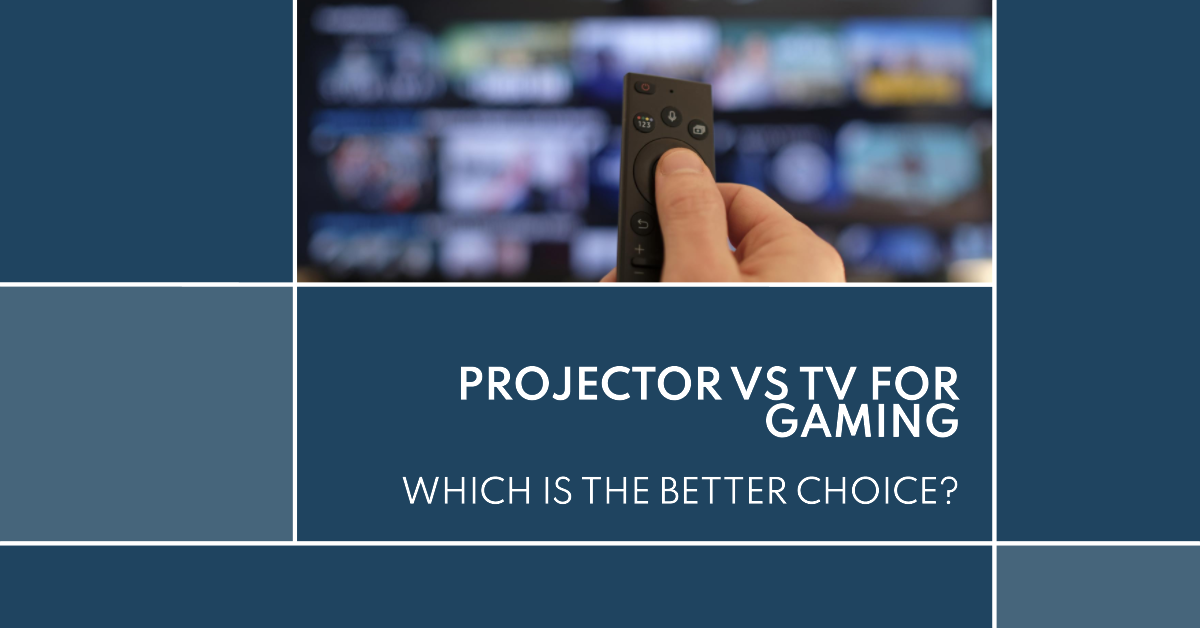Introduction
Gaming has become one of the top uses for home entertainment devices. Both projectors and TVs can provide immersive gaming experiences, but each has advantages and disadvantages. When choosing between a projector or TV for gaming, factors like image quality, input lag, sound, size/portability, and pricing should be considered.
In this comprehensive comparison guide, we’ll examine the key differences between gaming on a projector versus a TV to help you decide which is better suited for your needs.
Image Quality
Resolution
For crisp image quality, a 1920 x 1080 (1080p) resolution or higher is recommended for gaming. Most decent projectors and mid-range/high-end TVs support at least 1080p. Higher resolutions like 4K are ideal but require more expensive projectors or TVs to achieve.
Winner: Tie
Brightness
Projectors are measured in lumens while TVs use nits. Gaming projectors average 2,000 – 5,000 lumens which allows playable visibility even in some ambient light. TVs can get significantly brighter at over 1,000 nits.
Winner: TV
Contrast Ratio
This measures a display’s range between the brightest white and darkest black. Projectors typically have 2000:1 – 5000:1 contrast compared to TVs which can exceed 100,000:1 for deeper blacks.
Winner: TV
Color Quality
Modern projectors and TVs can produce over a billion colors. Mid-range devices of both types have 80 – 95% Rec 709 color gamut coverage for vibrant, accurate hues. High-end projectors and TVs with wide color gamuts and HDR excel at color reproduction.
Winner: Tie
Viewing Angles
TVs use LCD and LED screens that can look washed out when viewed from the side. Projectors cast a wider viewing angle so color and brightness remain more consistent side-to-side.
Winner: Projector
Response Time
Important for fast action games, response time measures how quickly pixels change color. Projectors have 10 – 16 ms response times enabling smooth, crisp motion. TVs range from 5 – 25 ms with gaming modes optimizing response.
Winner: TV
Input Lag
Critical for competitive gaming, input lag measures the delay between controller input and screen reaction. TVs average 10 – 20 ms input lag. Projectors are slightly higher at 25 – 45 ms lag. Gaming projector models have dedicated low-lag modes.
Winner: TV
Sound Quality
Built-in Speakers
Projectors usually have 2 – 15 watt mono or stereo speakers that provide useable audio for gaming. TVs often have more powerful 20 – 80 watt speaker systems and added features like Dolby Atmos.
Winner: TV
External Sound System
Both projectors and TVs benefit from connecting to dedicated speaker systems and soundbars for an immersive gaming audio experience. TV optical and HDMI ARC ports make this easier.
Winner: TV
Screen Size and Portability
Display Size Options
Projectors cast an image size determined by their projection distance, commonly 100 – 300 inches. TVs are available in smaller fixed sizes, typically 55 to 85 inches.
Winner: Projector
Portability
TVs are large, heavy devices meant for fixed placement. Many projectors weigh 5 – 15 pounds for easier transport and short throw models allow positioning close to the wall or screen.
Winner: Projector
Projector Placement Flexibility
With lens shift and keystone correction, projectors allow flexible placement relative to the wall or screen. TVs must be placed centered directly in front.
Winner: Projector
Pricing
Projector Cost
Home theater projectors range from $500 – $5000+ depending on resolution, brightness, and features. More budget-friendly portable projectors cost less than $200. High-end gaming projectors exceed $1000.
TV Cost
Entry-level 1080p TVs start under $300. High-performance 4K TVs with gaming enhancements can cost $2000+ for 65 inches. Larger premium TVs run $3000 – $5000+.
Winner: TV
Long-Term Cost Comparison
Projectors use lamps with a lifespan of 3,000 – 20,000 hours costing $100 – $300 to replace. TVs have backlight lifespans of over 60,000 hours and don’t require replacement.
Winner: TV
Conclusion
For gaming, both projectors and TVs have advantages depending on factors like image quality, sound, screen size, and pricing. Projectors offer massive, cinematic image sizes not possible with TVs. Their flexible placement, wider viewing angles, and portable options are also useful benefits.
However, TVs provide key advantages like higher peak brightness, superior contrast, faster response times, and lower input lag. Integrated smart platforms and speaker systems also help improve the gaming experience. While pricier upfront, TVs have a lower long-term cost of ownership without the need to replace lamps.
Consider your gaming habits, room setup, budget, and desired features when deciding between a projector or TV. While both can provide immersive gaming, choosing the display technology that best fits your needs will ensure the ultimate gaming experience.

